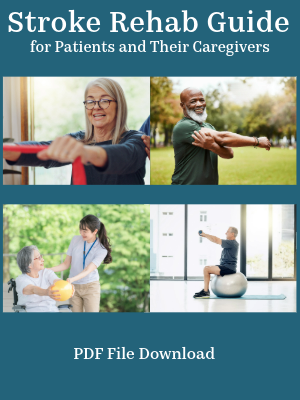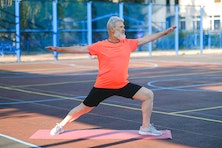Balance Exercises
Medically reviewed by Karen Murray, OTR, CHT, CSRS - written by Stroke-rehab.com
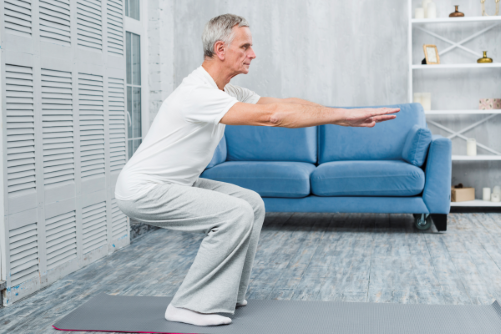
Balance exercises are important in helping prevent falls and improving mobility. For individuals who have experienced moderate to severe strokes, the loss of sitting balance is a common effect that occurs and often needs to be addressed early in the stroke rehabilitation process. The ability to maintain balance while seated serves as a fundamental requirement for engaging in essential activities of daily living, such as dressing, bathing, and toileting. One cannot learn to stand safely until sitting balance is maintained first.
The exercises below are examples of how to improve sitting and standing balance. However, it is imperative that you consult with your physician or therapist to ensure these exercises are both safe and suitable for your specific circumstances. Try our stroke rehab guide if you are looking for a list of comprehensive exercises and stroke recovery information.
Sitting Balance Exercises
Weight Shift Side to Side
Shift weight over the right hip then the left hip. Ribcage should move side to side and hip should lift off of surface. Don't bend at the waist to lean. Repeat the movement side to side. Books are placed under the hands while sitting to allow weight bearing through arms and to keep the hands from coming up off the sitting surface.
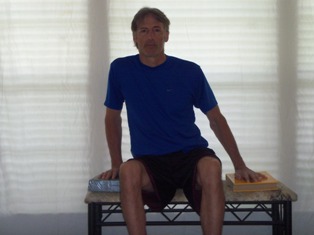 |
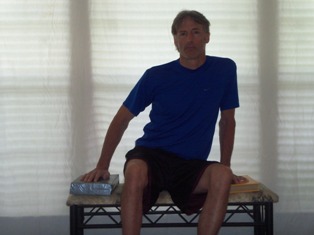 |
Weight Shift Forward and Back
Shift your weight forward and back by arching and rounding your low back. Repeat the movement shifting your weight forward and back.
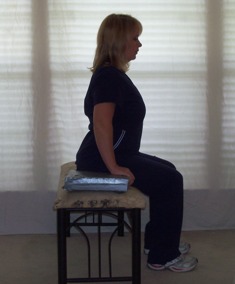 |
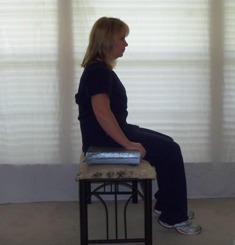 |
Leaning Down on Elbow
Lean down on to right elbow then push back up to center. Lean down on left elbow then push back up to center. Repeat as able.
 |
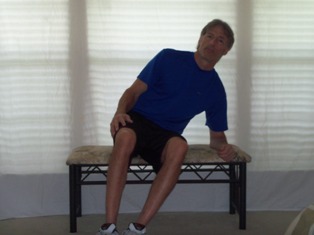 |
Reaching Toward Weak Side
Reach your non-affected arm out towards the weak side while bearing weight through the weak or paralyzed arm. If the weak arm buckles or the hand slides, have a helper support the weak arm at the wrist and just above the elbow. You can also try reaching in various directions while weight bearing on the affected arm.
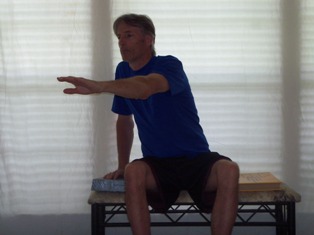 |
Reaching Forward with Clasped Hands
Clasp hands together and reach forward then sit back up straight. Sometimes it helps to put a target in front of you to touch. Repeat movement touching target as then sitting back up straight as able.
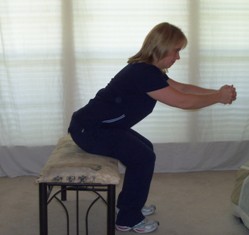 |
Standing Balance Exercises
Standing exercises should be done with a therapist or trained caregiver when the patient has unstable standing balance. Holding to a chair or counter or having a chair behind the patient may also be needed for safety. Patients should always check with their PT or OT to see what balance exercises are appropriate for their situation.
Sit to Stand with Clasped Hands
Clasp hands together and reach forward lifting bottom off of sitting surface then coming to full stand if able. If unable to do full stand, a partial stand is acceptable. Return to seated position then repeat as able.
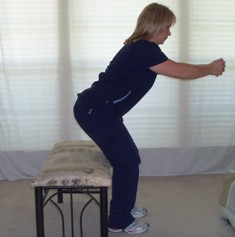 |
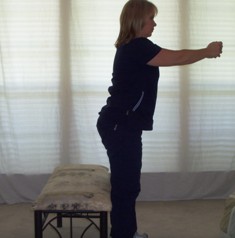 |
f
Lateral Weight Shift (side to side)
While standing in place, shift your weight to the right and then to the left.
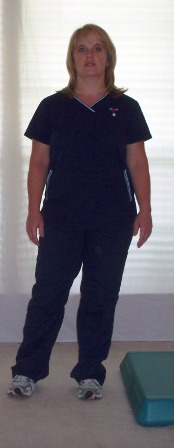
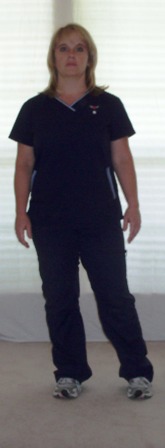
Weight Shift Forward and Back
While in a standing position and knees partially bent, slowly shift your body weight forward and then back.
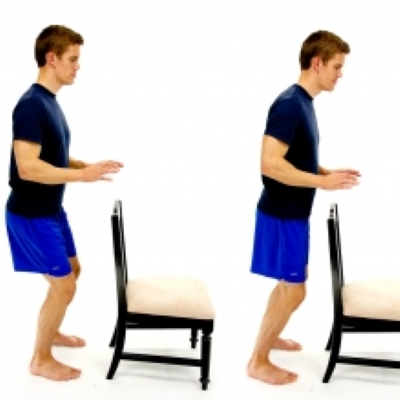 Pic provided by HEP2Go.com
Pic provided by HEP2Go.comStanding One Foot in Front of Other
Place one foot in front of the other with feet slightly apart. Maintain your balance while standing.
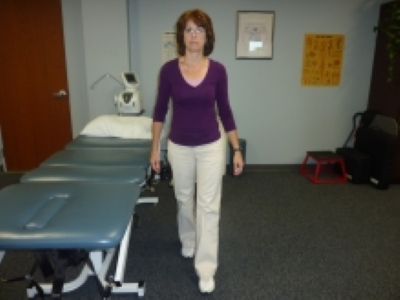 Pic provided by HEP2Go.com
Pic provided by HEP2Go.comThese are just a few starting balance exercises. There are many other exercises that can be done to advance your balance. Check with your therapist for a balance home exercise program.
How Many Repetitions of Exercise?
Research in the field of neuroplasticity has demonstrated that numerous repetitions of an activity should be performed over an extended period to "relearn" movement patterns. Since balance exercises can be physically demanding, particularly for individuals with limited trunk control, it is advised to start gently at first with fewer repetitions if needed.
Over time, gradually increase the number of repetitions you perform, ensuring you do so within your capacity without risking injury, muscle strain, or discomfort. Should you find a particular exercise too simple or easy, challenge yourself by attempting more advanced exercises. However, only do so in a safe environment and under the recommendation of your medical doctor or rehabilitation therapist.
When engaging in any balance activities after stroke, it is highly recommended to have the presence of a therapist or a trained caregiver to assist you, minimizing the risk of falls.
Other Balance Exercises
For further information and answers to questions about balance problems, visit https://www.stroke-rehab.com/balance-problems.html or visit https://www.stroke.org.uk/sites/default/files/user_profile /balance_problems_after_stroke.pdf for some great information on balance including how your balance can be affected after stroke and tips to avoid falling.
Get Our Stroke Rehab Guide

Our stroke rehab guide is designed specifically for patients and caregivers. It's in pdf format and can be immediately downloaded. It includes about
- Stroke Definition & Causes
- Stroke Treatment
- Rehabilitation Information for Physical, Occupational and Speech Therapy
- Exercise pictures
- Q&A from patients and caregivers
- Adaptive Equipment & Techniques
- How to Prevent Another Stroke & More!
Photo Credit for Top Image: Image by Freepik
Medical Disclaimer: All information on this website is for informational purposes only. This website does not provide medical advice or treatment. Always seek the advice of your physician or other healthcare provider before undertaking a new healthcare or exercise regimen. Never disregard professional medical advice or delay seeking medical treatment because of something you have read on this website. See the disclaimer page for full information.
- Home
- Balance Exercises
